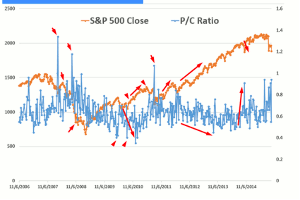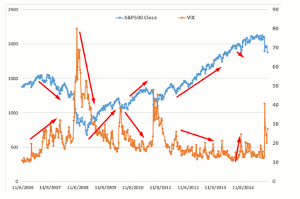Options data points tend to show a very high level of volatility in a short period of time, and Shobhit Seth, at Investopedia.com, explains that when correctly analyzed by using the right indicators, they can provide meaningful insights about the movement of the underlying security.
Every trader and investor asks, “Where is the overall market (or a specific security price) headed?” Several methodologies, intensive calculations, and analytical tools are used to predict the next direction of the overall market or of a specific security. Options market data can provide meaningful insights on the price movements of the underlying security. We look at how specific data points pertaining to options market can be used to predict future direction.
This article assumes reader’s familiarity with options trading and data points.
Options Indicators for Market Direction
The put-call ratio (PCR): PCR is the standard indicator that has been used for a long time to gauge the market direction. This simple ratio is computed by dividing the number of traded put options by the number of traded call options. It is one of the most common ratios to assess the investor sentiment for a market or a stock. (For more, see: What is the put-call ratio and why should I pay attention to it?)
Multiple PCR values are readily available from the various option exchanges. They include total PCR, equity-only PCR, and index-only PCR values. Total PCR includes both index and equities options data. Equity-only PCR contains only equity-specific options data and excludes index options. Similarly, index-only PCR contains only index-specific options data and excludes equities options data.
The majority of the index options (put options) are bought by fund managers for hedging at a broader level, regardless of whether they hold a smaller subset of the overall market securities or whether they hold a larger piece. For example, a fund manager may hold only 20 large-cap stocks, but may buy put options on the overall index which has 50 constituent stocks.
Due to this activity, the index-only PCR and the total PCR (which include index options) values do not necessarily reflect the precise option positions against the underlying holdings. It skews the index-only and total PCR values, as there is a greater tendency to buy the put options (for broad-level hedging), rather than the call options.
Individual traders buy equity options for trading and for hedging their specific equity positions accurately. Usually there is no broad-level hedging. Therefore, analysts use the equity-only PCR values, instead of the total PCR or the index-only PCR.
The historical data from November 2006 to September 2015 for CBOE PCR (equity-only) values against the S&P 500 closing prices indicate that an increase in PCR values was followed by declines in the S&P 500 and vice-versa.
As indicated by red arrows, the trend was present both over the long-term and in the short-term. No wonder then that PCR remains one of the most followed and popular indicators for market direction. Experienced traders also use smoothening techniques, like the 10-day exponential moving average, to better visualize changing trends in PCR.
NEXT PAGE: What About Value Thresholds?
|pagebreak|To use PCR for movement prediction, one needs to decide about PCR value thresholds (or bands). The PCR value breaking above or below the threshold values (or the band) signals a market move. However, care should be taken to keep the expected PCR bands realistic and relative to the recent past values. For example, from 2011 to 2013, PCR values remained around 0.6. The trend seemed to be downwards (although with low magnitude), which was accompanied by upward S&P 500 values (indicated by arrows). The sporadic jumps in the interim provided a lot of trading opportunities for traders to cash in on short-term price moves.
Any volatility index (like VIX, also called the CBOE volatility index) is another indicator, based on options data, that can be used for assessing the market direction. VIX measures the implied volatility based on a wide range of options on the S&P 500 Index.
Options are priced using mathematical models (like the Black Scholes Model), which take into account the volatility of the underlying, among other values. Using available market prices of options, it is possible to reverse-engineer the valuation formula and arrive at a volatility value implied by these market prices.
This implied volatility value is different than volatility measures based on historical variation of price or statistical measures (like standard deviation). It is considered better and more accurate than historical or statistical volatility value, as it is based on current market prices of option. The VIX Index consolidates all such implied volatility values on a diverse set of options on the S&P 500 Index and provides a single number representing the overall market implied volatility. Here is a comparative graph of VIX values versus S&P 500 closing prices.
As can be observed from the above graph, relatively large VIX movements are accompanied by movements of the market in the opposite direction. Experienced traders tend to keep a close eye on VIX values, which suddenly shoot up in either direction and deviate significantly from recent past VIX values. Such outliers are clear indications that market direction can change significantly with larger magnitude, whenever the VIX value changes significantly. The visible long-term trend in VIX indicates a similar and consistent long-term trend in the S&P 500 but in the opposite direction. Options-based VIX values are used for both short- and long-term market direction predictions.
The Bottom Line
Options data points tend to show a very high level of volatility in a short period of time. When correctly analyzed using the right indicators, they can provide meaningful insights about the movement of the underlying security. Experienced traders and investors have been using these data points for short-term trading, as well as for long-term investments.
By Shobhit Seth, Contributor, Investopedia.com












